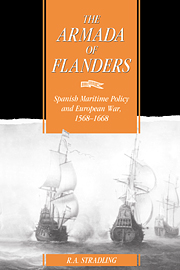Book contents
- Frontmatter
- Contents
- Preface
- Acknowledgements
- Glossary
- Rough comparative values of Spanish and Flanders currencies, c. 1620–60
- List of abbreviations
- Maps
- Part I Prologue – Failure and retrenchment, 1568–1621
- 1 The search for a naval policy
- 2 Dunkirk rediscovered
- Part II The great offensive, 1621–1640
- Part III Dunkirk and the defence of Empire, 1640–1658
- Part 4 Quills, keels and cutlasses
- Epilogue Decay and transition, 1658–1668
- Appendices
- Bibliography
- Index
- Cambridge Studies in Early Modern History
1 - The search for a naval policy
Published online by Cambridge University Press: 22 September 2009
- Frontmatter
- Contents
- Preface
- Acknowledgements
- Glossary
- Rough comparative values of Spanish and Flanders currencies, c. 1620–60
- List of abbreviations
- Maps
- Part I Prologue – Failure and retrenchment, 1568–1621
- 1 The search for a naval policy
- 2 Dunkirk rediscovered
- Part II The great offensive, 1621–1640
- Part III Dunkirk and the defence of Empire, 1640–1658
- Part 4 Quills, keels and cutlasses
- Epilogue Decay and transition, 1658–1668
- Appendices
- Bibliography
- Index
- Cambridge Studies in Early Modern History
Summary
SAILING IN THE DARK
Both as explosive event and as continuing phenomenon, the Revolt of the Netherlands was the fundamental conditioning factor in the experience of Spain's European hegemony. Yet it could not have developed beyond its earliest stages, nor would the unlikely revival of its fortunes spearheaded by the ‘Sea-Beggars’ in 1572 have stood much chance of success, if Philip II and his ministers had been as assiduous in the creation of a North Sea navy as they were in the establishment of the celebrated army of Flanders. The presence of appropriate Spanish squadrons and bases in the Rhine delta and the Hook of Holland would surely have provided a deterrent, just as their absence acted as an incentive, to the motley heroes of Motley.
Having made such a fundamental (and hypothetical) stricture, we must qualify it in several important respects. In fact, the duke of Alba, Philip's governor and military commander in the Low Countries, did dispose of a force which could loosely be called naval in 1572. This mainly comprised small, if numerous, craft – above all, expropriated river barges and sloops, whose routine function was the service and support of essentially terrestrial operations. Even had the duke been willing by temperament to divert his attention from the latter, his resources were hardly suited to the task of policing the dangerous waters to the seaward of the major Dutch islands.
- Type
- Chapter
- Information
- The Armada of FlandersSpanish Maritime Policy and European War, 1568–1668, pp. 3 - 15Publisher: Cambridge University PressPrint publication year: 1992



